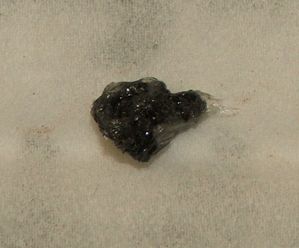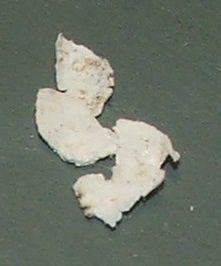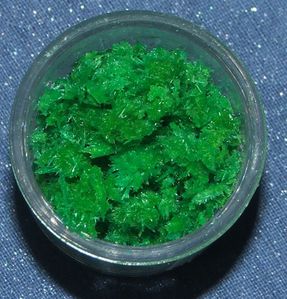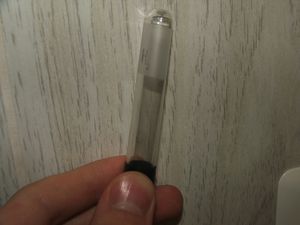June 9 2011
4
09
/06
/June
/2011
15:10
Warning: Copper(I) chloride is toxic. Do not eat the precipitate or drink the solutions. Otherwise, everything is safe.
This is the beginning of the copper(II) chloride series of experiments. A wide range of experiments with copper(II) chloride can be done by the home chemist. Information on how to make copper(II) chloride can be found here: http://lanthanumkchemistry.over-blog.com/article-how-to-make-copper-ii-chloride-76079848.html
You will need:
Ascorbic acid (found as Vitamin C crystals)
Previously made copper(II) chloride
Filter paper, tissues, or coffee filter paper
A container
Copper wire
3% hydrogen peroxide, optional
Dissolve a small amount of copper(II) chloride in water. Add ascorbic acid. A color change from blue to green to a white precipitate is observed. This white precipitate is copper(I) chloride. Filter it. Copper(I) chloride is easily oxidized by air. Within a few minutes of being in air, the filter paper should start turning green again. Before it dries, it will be completely green. When I conducted this experiment, the copper(I) chloride took about 10 minutes to begin turning green. Make another small batch. Filter and let it dry until it just starts turning green. Add hydrogen peroxide to the filter paper. It should immediately turn green. The hydrogen peroxide oxidizes the copper(I) chloride to copper(II) chloride and copper(II) hydroxide. Both of these chemicals are green or blue-green.
Here are pictures of the reaction and the resulting white precipitate. Asc stands for ascorbate, the part of the ascorbic acid that reduces the copper(II) to copper(I). H+ stands for the acid part of ascorbic acid, which makes the solution turn greenish.

Method 2: Dissolve copper(II) chloride crystals in concentrated hydrochloric acid. Add copper metal and heat. This comproportionation reaction will occur: CuCl2 + Cu --> 2 CuCl. Add sodium bicarbonate to the resulting dark solution until a pure white precipitate falls out. The leftover solution will probably be greenish as a result of excess copper(II) chloride. This white precipitate is copper(I) chloride.
Published by LanthanumK
-
in
Experiments
June 9 2011
4
09
/06
/June
/2011
14:54
As I had stated in an earlier post, I have compiled a list of sources for the elements that are available to the amateur chemist. Lithium will be discussed here.
Lithium is a soft, malleable, gray alkali metal. It tarnishes to purple, then black, then white in air. It reacts with water, releasing lithium hydroxide solution, steam (from the heat of the reaction), and hydrogen gas. Lithium is the lightest metal, about half as dense as water. Lithium burns in air with a brilliant white flame, making lithium oxide, which produces a crimson flame color. Ltthium is the only alkali metal easily accessible by amateur chemists.
In element form: Lithium is found in Energizer Ultimate Lithium batteries. These are difficult to open and easy to short circuit. Lithium is also found in the CR-xxxx series of coin cells. After peeling back the cathode, the manganese dioxide and the separator paper is removed, exposing a slice of lithium metal. Lithium can be preserved in petroleum jelly.
In compound form: Lithium reacts with water to make lithium hydroxide, which after exposure to air precipitates lithium carbonate if it is concentrated enough. Lithium ion batteries contain lithium compounds. Some piezocrystals are made of lithium niobate. Lithium grease is made from lithium stearate, a lithium soap.
This is one of my pieces of lithium. It is stored in a container of petroleum jelly. Since some oxygen is present in petroleum jelly, it has turned black. Below this is a picture of a lithium chunk that has been set out to oxidize. It has disintegrated into crumbly lithium carbonate.


Published by LanthanumK
-
in
Elements
June 8 2011
3
08
/06
/June
/2011
13:40
Warning: Copper(II) chloride is toxic. Do not eat the crystals or drink the solution. Avoid getting the acidic solutions on your hands or face. To be safe, wear gloves and goggles. Keep crystals out of reach of children, unless they have extreme copper deficiency and need the copper (do not take this last sentence seriously).
This article will describe several processes that can be used for creating this chemical.
- Mix hydrogen peroxide with hydrochloric acid. 30% peroxide is better than 3%. Add copper. A green solution of copper(II) chloride is produced. Evaporate and obtain the crystals. If you use 3% hydrogen peroxide, you may get next to nothing. As this experiment is very cheap, you can reproduce it with different levels of hydrogen peroxide and hydrochloric acid to find the ideal mixture. After trying this method, it works wonderfully. However, if not enough hydrogen peroxide is used, the copper reacts with the acidic copper(II) chloride solution to generate a dark green mixed copper(I)/copper(II) complex, which can cause problems as the salt dries, including the formation of an insoluble oxychloride or a monovalent chloride. Add a little more hydrogen peroxide if a dark green coloration is observed after dissolution is completed. If it changes color (gets more bluish), add more peroxide until it stops changing color. If the resulting blue solution is not clear, it means that there is not enough hydrochloric acid present. Add more HCl until the solution clears.
- Dissolve sodium bicarbonate in water. Strip two copper wires. Place them in the solution. Connect a 12VDC power supply to them. Hydrogen and copper(II) hydroxide and copper(II) carbonate are produced. The hydrogen is seen as bubbles at the cathode. Oxygen may be released as bubbles at the anode. A blue precipitate of copper compounds begins to form at the anode. Scrape the wires periodically to remove loose precipitate. Eventually, the wire will become so encrusted with black copper(II) oxide that the electrolysis will stop. Filter and dry the precipitate. You may reuse the solution for more copper electrolysis experiments. This precipitate is mainly basic copper carbonate. Add hydrochloric acid to it until most of it is dissolved and put it out to evaporate. The rest of the copper carbonate should dissolve and the solution should be very dark green. After evaporation, beautiful copper(II) chloride crystals should be in the container. This method produces more CuCl2 than the previous method but is not as simple. The picture shows about 5 grams of green CuCl2 dihydrate produced by that process. I prefer this method because of its high yield and uncomplicated procedure (joke). Update: In reality, it is very low yielding and a highly complicated procedure.
- Heat copper shavings and drop them in chlorine gas. This produces the brown anhydrous form of CuCl2.
- For a solution containing both copper and chloride ions without any pure copper(II) chloride, just mix blue copper sulfate solution, which tends to be more readily available, with sodium chloride to form the more greenish copper chloro complex.

This copper(II) chloride will be used in later experiments.
Published by LanthanumK
-
in
Experiments
June 8 2011
3
08
/06
/June
/2011
13:00
You will need:
3% hydrogen peroxide solution
Sodium bicarbonate (baking soda)
Mix ½ cup (115 mL) hydrogen peroxide and 10 g of baking soda in a cup. Let it sit until the hydrogen peroxide starts fizzling. Start your washer, pour the solution in, and let it run through a cycle (rinse only cycle is recommended). Add some scent if desired.
The chemical explanation of this process is: The hydrogen peroxide is adducted to the sodium bicarbonate, forming sodium percarbonate in situ. Sodium percarbonate is used in commercial washer fresheners.
Published by LanthanumK
-
in
Experiments
June 8 2011
3
08
/06
/June
/2011
12:47
As I had stated in an earlier post, I have compiled a list of sources for the elements that are available to the amateur chemist. Helium will be discussed here.
Helium, is a colorless, tasteless, odorless, nontoxic, nonflammable, nonreactive, light gas. (Enough properties?) It has the lowest melting point of any element. Helium is rare on the earth but is more common in the universe. Here are some of its sources (a clump of spent star is not included):
In element form: Helium is used in balloons. Helium is also used in welding.
In compound form: Helium does not form any stable compounds.
This is my sample of helium gas. It was filled by a tank of helium gas at a welding shop. It is stored in a plastic test tube.

Published by LanthanumK
-
in
Elements
June 7 2011
2
07
/06
/June
/2011
22:57
In my search for chemistry sites, I have come across some that I feel are helpful to the amateur chemist:
Other interesting websites are here:
Published by LanthanumK
June 7 2011
2
07
/06
/June
/2011
22:03
Warning: This experiment produces moderately toxic copper sulfate. Do not dump more than a small amount down the sink. Do not drink the solution or eat the crystals.
This article will detail the process of creating a dirt-cheap impure form of copper sulfate using these simple household substances: copper wire, magnesium sulfate (Epsom salts), a container, and a 12VDC power supply.
Dissolve the magnesium sulfate in warm water to make a concentrated solution. Strip two lengths of copper wire (stranded is better than solid) and immerse them in the magnesium sulfate electrolyte. Attach them to the 12VDC power supply. They should not be near each other. Turn the power supply on.
At once, large quantities of hydrogen bubbles should be seen coming from the negative electrode (cathode), while small quantities of oxygen come from the positive electrode (anode). A white flaky solid should form at the cathode, and a light blue solution should start forming at the anode. Remove as much of the white flaky solid, a magnesium hydroxide precipitate, as you can. This will prevent it from redissolving and stopping the copper sulfate from forming. When the white precipitate starts becoming bright blue, stop the electrolysis and remove the copper wires. What you have is a solution of copper sulfate mixed with a large quantity of magnesium sulfate. The copper wire functioning as an anode should be somewhat corroded, and the other wire should be unchanged. Evaporate the blue solution. It should become bluer and eventually slushy blue crystals should start precipitating. After a while of being exposed to air, they will turn a dirty green because the copper sulfate has lost part of its water of hydration.
If you want pure copper sulfate, just buy it. Making it will require purchasing sulfuric acid and electrolytically oxidizing the copper in a sulfuric acid bath (some copper may plate out again at the cathode). Making it is not very economical.
Published by LanthanumK
-
in
Experiments
June 7 2011
2
07
/06
/June
/2011
16:54
I have collected over 30 elements from household substances for less than 15 dollars. Many more elements are available as well, although I have not collected them personally. I have compiled a list of sources for all of the elements that can be obtained by the average person. Every day, I will post a different element. Today's element is hydrogen.
Hydrogen is a colorless odorless gas. It is nontoxic. It burns readily in air. It is the least dense substance. It is the most abundant element in the universe and is very common on the earth in the form of hydrogen compounds. Here are some of its sources:
In element form: The reaction of an active metal such as zinc with water creates hydrogen gas. Electrolysis of water with sodium bicarbonate electrolyte produces hydrogen gas at the cathode.
In compound form: Hydrocarbons, acids, bases, and water all contain hydrogen atoms.
This is my sample of hydrogen gas. It was generated by electrolysis of sodium bicarbonate solution with 12VDC. A carbon anode and carbon cathode were used. It is stored in a plastic test tube.

Published by LanthanumK
-
in
Elements
June 7 2011
2
07
/06
/June
/2011
16:43
This automated message is the first article of your blog. It will help you get started with OverBlog. You can edit or delete it by going to the "Publish" section of your administration page.
Hope you'll enjoy blogging with us!
The OverBlog team
PS: In order to log in to your administration panel go to OverBlog portal.
Published by OverBlog








